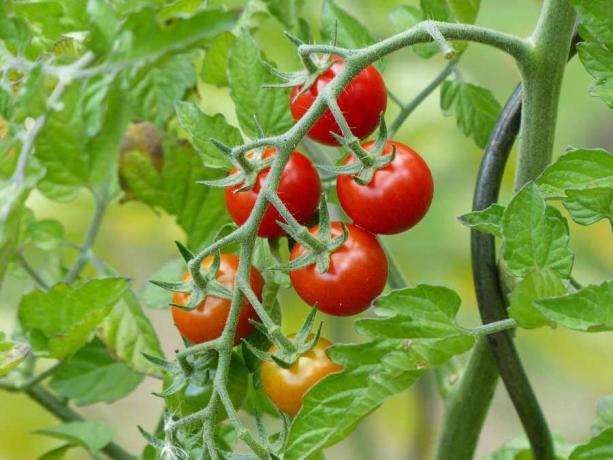The tomato 'Philovita F1' convinces with its small, fruity-sweet fruits. In this article we show what you should consider when planting and caring for the Philovita tomato.

The fruity sweet tomato 'Philovita F1' is particularly characterized by its many disease resistances. We present the robust and high-yielding tomato variety and give tips on growing and using the Philovita tomato.
contents
- Tomato 'Philovita': profile
- origin and history
- Taste & characteristics of the tomato variety 'Philovita F1'
- Planting and caring for the Philovita tomato
- Harvesting and using the 'Philovita' tomato
Tomato 'Philovita': profile
| fruit | cherry tomato; deep red |
| the taste | fruity, aromatic, sweet with a slight acidity |
| maturing time | early |
| growth | Stick tomato, up to 2 m |
| location | greenhouse, open ground, pot |
origin and history
The 'Philovita F1' variety comes from De Ruiter Seeds, a company that belongs to the Bayer-Monsanto complex. It was probably created around the turn of the millennium, but no further details are known. The Philovita tomato was bred as a commercial variety for greenhouse cultivation, with a focus on disease tolerance and high yield. The 'Philovita F1' is a hybrid variety, it is only created through the targeted crossing of two selected parent plants. Descendants of the 'Philovita F1' therefore usually show different characteristics than the original variety, so the variety is not seed-proof. The seeds for the Philovita tomato have to be bought again and again from the breeding companies.
Taste & characteristics of the tomato variety 'Philovita F1'
Plants of the tomato variety 'Philovita F1' grow quite slowly and still reach a height of up to two meters. Plants grown with multiple shoots remain smaller and therefore become wider. The deep red, round fruits weigh about 15 grams and shine conspicuously when ripe. The tomatoes hang tightly together on long panicles with up to 70 fruits. The taste of the Philovita tomato is fruity and sweet-aromatic with a slight acidity. Even when fully ripe, the skin remains crisp and the flesh remains juicy. 'Philovita F1' is insensitive to velvet spot disease (Cladosporium fulvum), foot rot and wilt Fusarium, the tomato mosaic virus (TMV) and the dreaded Late blight and late blight (Phytophthora infestans). Thus, it is resistant to the most important pathogens in greenhouse cultivation of tomatoes. How your Protect tomato plants from diseases you can find out in our special article.

Planting and caring for the Philovita tomato
'Philovita F1' is particularly suitable for cultivation under glass, but also outdoors and as balcony tomato she feels comfortable in the pot and produces good yields. Young plants of the 'Philovita F1' can move into the greenhouse from the beginning of May. You should only put the tomato plants in the bed and on the terrace or balcony after the ice saints in mid-May. For cultivation in a tub, fill a large planter half full with substrate specially adapted to tomatoes, like ours Plantura organic tomato & vegetable soil. The nutrients contained in the substrate promote the growth of the young plants. The high compost content with lots of wood fiber replaces the water-storing effect of peat, making our soil completely climate-neutral. Now place your Philovita tomato in the pot, remove any leaves that are too deep and fill the pot up to the brim with soil. Lightly press down the soil around the plant and then water extensively.
Once the 'Philovita F1' has found its final place, it can soon be well supported and tied up. As a small-fruited cherry tomato, the 'Philovita F1' does not necessarily have to be exhausted, but with less space and light you can also grow it with five shoots. The fruits ripen faster and the plant dries faster when it rains because there are fewer shoots and leaves. From June, the many fertilized flowers begin to grow and small fruits appear. Now it is worth fertilizing for the first time, because the cherry tomato needs large amounts of nutrients to supply the rich harvest. Using an organic liquid fertilizer like ours Plantura Organic Tomato & Vegetable Fertilizer, the plants of the 'Philovita F1' variety can be easily fertilized with irrigation water. About once a week, the organic quality liquid fertilizer is dissolved in the water and the plants watered with it. The high potassium content promotes fruit growth and later the storability of the ripe fruit.
Harvesting and using the 'Philovita' tomato
From mid-July the time has finally come: The first fruits of the 'Philovita F1' shine in deep red and can be harvested. The hybrid variety bears reliably and plentifully well into autumn. Most of the fruits will hardly make it into the kitchen, because they simply taste best when they are still warm in the sun, straight from the vine. The Philovita tomato is also very suitable for processing and refines any tomato sauce or soup with its aroma.
Once upon a time, tomatoes always had to be red and round. We present you the sunny yellow sweet tomato 'date wine’, which not only draws everyone’s attention with its cheerful colour, but also with its very special shape.



